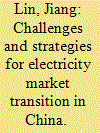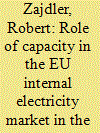|
|
|
Sort Order |
|
|
|
Items / Page
|
|
|
|
|
|
|
| Srl | Item |
| 1 |
ID:
168653


|
|
|
|
|
| Summary/Abstract |
China is currently pursuing electricity reforms that will create wholesale markets for electricity. Electricity markets hold considerable promise for facilitating China's transition to clean energy systems, but face obstacles. The most significant obstacle to market reforms is their potential financial impact on coal generation, which currently accounts for most of China's generating capacity. In this paper, we examine the impact of market reforms on coal generation in China, using Guangdong Province as a case study. We find that, in the near term, market prices are likely to lead to significant decreases in net revenues for coal generators relative to the current benchmark tariff, with 40%–60% of coal generation capacity unable to cover the cost of remaining in commercial operation. We estimate that existing coal generators in Guangdong had 94 billion yuan (US$14 billion) in outstanding debt in 2016, creating large risks for banks and raising questions about the potential impacts of electricity market reforms on China's financial industry. The impact of market reforms on coal generators creates two problems—transition and resource adequacy. The development of mechanisms for long-term resource adequacy provides a common solution to both of these problems.
|
|
|
|
|
|
|
|
|
|
|
|
|
|
|
|
| 2 |
ID:
177328


|
|
|
|
|
| Summary/Abstract |
In most liberalized electricity markets, flaws in short-term price formation have led to a “missing money” problem wherein average energy prices are too low to support an efficient level of capacity. Recent growth of wind and solar generation has exposed another category of flaws related to intertemporal constraints, such that energy prices are not volatile enough to support an efficient level of flexibility. In theory, electricity markets convey the value of flexibility through time-varying prices, encouraging market participants to invest in resources able to match production and consumption profiles to grid needs. Real-world market clearing procedures, however, make several simplifications that suppress volatility relative to the theoretical ideal. This paper describes five mechanisms by which current wholesale electricity market price formation may fail to provide full-strength incentives for flexible resources. Instead of restoring price volatility, market designers may choose to define flexibility products that act as a proxy for full-strength prices. However, these products cannot replicate theoretically ideal incentives precisely, with potentially important consequences for small-scale and distributed resources. The analysis could help guide ongoing efforts to ensure that systems have the capability to respond to growing variability and uncertainty in an efficient way.
|
|
|
|
|
|
|
|
|
|
|
|
|
|
|
|
| 3 |
ID:
177319


|
|
|
|
|
| Summary/Abstract |
Resolving the resource adequacy problem has been usually entrusted to the imposition of some kind of long-term capacity requirements or to forward markets. The Operating Reserve Demand Curve (ORDC), which is linked to short-term market conditions and does not require central planning, has been presented as an alternative system with which to ensure long-term resource adequacy in the market. Using hourly data from the Texas ERCOT market between January 2015 and February 2019, we empirically show that ORDC prices are significantly negatively affected by wind generation. We find that, if wind generation is relatively low, a 1% increase in wind generation decreases the ORDC price by around 0.15–0.1%. This fact may preclude the ORDC from providing long-term price signals and price stability to generators. Moreover, we also find that if wind generation is greater than 9000 MW, the ORDC price is expected to be zero, which may further disincentive to increase generation capacity –especially dispatchable capacity that may be needed as a backup if the wind is not blowing.
|
|
|
|
|
|
|
|
|
|
|
|
|
|
|
|
| 4 |
ID:
114297


|
|
|
|
|
| Publication |
2012.
|
| Summary/Abstract |
In South Korea, the incentive scheme for generators to add new power generation is based on the system marginal price (SMP) and the capacity payment (CP). The infra-marginal generators receive an extra margin due to the high SMP level and the new infra-marginal generators need to be built to achieve the optimal fuel mix. However, the Metropolitan zone needs more marginal generators due to the transmission congestion and environmental regulations, but the marginal generator in the Metropolitan zone does not have adequate profits for the new investment under the current CP. This paper suggests the appropriate investment incentive scheme for different zones. The introduction of forward capacity markets for different regions creates higher capacity market prices in the Metropolitan zone than those in the Southern zone. The introduction of forward capacity market also induces a new LNG generator investment in the Metropolitan zone while only new infra-marginal generators need to be added in the Southern zone.
|
|
|
|
|
|
|
|
|
|
|
|
|
|
|
|
| 5 |
ID:
150368


|
|
|
|
|
| Summary/Abstract |
We investigate the resource adequacy requirements of the PJM Interconnection, and the sensitivity of capacity procurement decisions to the choice of reliability metric used to measure resource adequacy. Assuming that plants fail independently, we find that PJM's 2010 reserve margin of 20.5% was sufficient to achieve the stated reliability standard of one loss of load event per ten years, with 0.012 expected loss of load events per year. PJM could reduce reserve margins to 13% and still achieve adequate levels of reliability as measured by the 2.4 Loss of Load Hours metric and the 0.001% Unserved Energy metric, which are used by other U.S. and international systems. A reserve margin of 13–15% would minimize long-run system costs. Reducing reserve margins from 20.5% to 13% in 2010 would have reduced PJM's capacity procurement by 11 GW, the same amount of coal capacity that PJM has identified as at high risk of retirement. We also investigate the risk posed by correlated failures among generators, a risk traditionally not modeled by system planners. We illustrate that three types of correlated failures may increase outage risks: natural gas supply disruptions, reduced reliability among generators during winter months, and the simultaneous shutdown of multiple nuclear generators for regulatory reasons.
|
|
|
|
|
|
|
|
|
|
|
|
|
|
|
|
| 6 |
ID:
177477


|
|
|
|
|
| Summary/Abstract |
Since the judgment in Case 6/64 Costa v ENEL electricity (electrical energy) has been considered as ‘good’ subject to the principle of free movement of goods of the European Union (EU). Although the EU electricity market has undergone fundamental regulatory and technological changes, this qualification still determines the assessment of regulatory solutions. The changes that have taken place have made it possible for resource adequacy to be ensured not only by generators but also by “demand side management”. It changes the market from a single-product market where electricity is the exclusive commodity (‘good’) traded to a two-commodity market where capacity securing resource adequacy is the second product. It raises the question if the capacity is good or service and how it affects qualification of electricity as a good and a model for developing EU regulation based on this assumption. In Case T-793/14 Tempus Energy the General Court challenged the British capacity market which also affected the Polish one, showing the need for delimitation of this concept. The aim of this article is to try to give answers to these questions. The article aims to propose such a delimitation and the consequences that result from for the EU electricity market.
|
|
|
|
|
|
|
|
|
|
|
|
|
|
|
|
| 7 |
ID:
150345


|
|
|
|
|
| Summary/Abstract |
We analyse the joint problem of supporting renewables and resource adequacy in a liberalised electricity market and present a detailed model-based comparison of two alternative policies. We undertake this in the context of the British market. We show how, ceteris paribus, the progressive replacement of coal with wind imposes extra costs of reserve and evaluate alternative way to meet this, whether through capacity payments funded by customers, or a reliability requirement on wind generators with capital cost or energy feed-in subsidies. We consider the reality of market concentration and the extent to which pragmatic regulation could allow prices to rise above marginal cost to reduce the extent of direct subsidies and complex market designs. We also evaluate the implied cost of carbon reduction in a progressive replacement of coal with wind, when the security is maintained by extra peaking gas. We find that support through capital allowances rather than the energy market is more efficient.
|
|
|
|
|
|
|
|
|
|
|
|
|
|
|
|
|
|
|
|
|